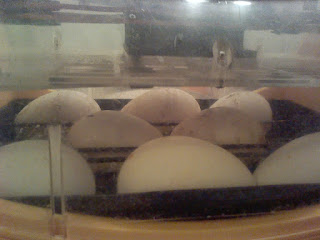Sandburr Hill Farm
Genesis 3:17-18: "...cursed is the earth for thy sake: in sorrow shalt thou eat of it all the days of thy life. Thorns also and thistles shall it bring forth to thee, and thou shalt eat the herb of the field."
Friday, December 28, 2018
We're Still Here!!
I finally got around to taking the cleaver to the blog -- never got around to updating it and we've changed what we're doing some (traded the dairy for the ability to vacation!)
I still update the Facebook page quite often, so if you're looking to catch up on what we're doing, please visit our page here. It's a lot easier to keep farm fans updated with a cell phone in my pocket and a Facebook page!
Or find the link to email us and we'll get back to you soon!
Wednesday, November 4, 2015
Round Bale Sheep Feeder
Not to steal thunder from Premier 1's big bale feeder found here:
http://www.premier1supplies.com/sheep-guide/2012/10/installing-premier-big-bale-feeders/
But with some time and tools, a close approximation can be made with feed store cattle panels (which Premier 1 says are inferior to theirs... I've never seen theirs, but I figure that the freight charges would be cost prohibitive).
I figured for a six-foot- diameter bale, three-foot panels (which ended up cut at 40 inches). I think for five-foot bales the panels could have been in two-foot or 30-inch segments.
I'll make another one for the goats. Still needing to be added to the sheep feeder is a roof to shed rain.
Photos below.
Friday, April 24, 2015
Buck Pen
Buck Pen
We needed a way to keep the buck away from his girls during the "off-season," but needed to keep our small pen open for birthing goats, etc. (that and he formerly folded down the cattle panel in there). Also gives the flexibility of pasture improvement in the back by keeping the animals off of new growth.Plans for the future will add a larger pen adjacent to this and maybe one at the downhill (West) side that'll connect the two and add a third pen. All will aide in partitioning off ewes with rams in the fall as well.
Loose fences are dangerous fences - and loose goats are goats that breed outta season. Big focus was to make it tight. Time will tell.
 |
| The corner posts came from the railroad ties that were lining the driveway -- I selected the good ones since there's a reason the railroad tore them out... |
 |
| The South side of the pen is using the existing field fence |
 |
| Cemented in with the bottom of the post buried in soil to facilitate drainage |
 |
| Chainsaw sculpting for the floating braces... next up a bear carved out of a stump... and it snowed last night |
 |
| So they're not exactly floating braces when you cement the "floating" end in the ground |
 |
| 12.5 ga wire will turn into a big slinky real fast if you're not careful |
 |
| Make a loop, wrap one end around the bottom of your post, notch the bottom of the brace, staple it securely (but not tightly) in place... |
 |
| And tension the brace wire... don't use these kind... |
 |
| Striaght 'nuff |
 |
| A truck makes a good tension anchor... when it starts to slide backward, you've tensioned enough |
 |
| Fence |
 |
| Electric wire helps keep him off too... |
 |
| Beginnings of a shelter |
 |
| Our cold and wet weather always comes from the North and West -- I'll eventually add an half wall to the South side... looks like he enjoys it though! |
Wednesday, March 18, 2015
Cheese Making!
Making Mozzarella
Since we have a surplus of milk, I took a shot at cheesemaking, using a recipe found here. After adding citric acid to the cold milk, warming to 90 degrees and stirring in the rennet, below is what it looks like. |
| Testing the curds - the whey should be clear and the curds stiff enough to peel back like this. I left it to sit beyond the recommended 5 minutes to get to this point. |
 |
| Cutting the cheese (nyuck nyuck!) |
 |
| After heating the curds up to 110 degrees, removing from heat, and stirring for about 5 minutes, you drain the creamy whey off -- it went into pancakes this morning. |
 |
| Soak in cold water, wrap, and you have cheese! |
 |
| Back to the big pot of yellow whey (which after some later reading I found is handy to keep hot for bathing the cheese in as you stretch it), heat the whey to 200 degrees and let it cool. |
 |
| The proteins that are left over bind together and float -- ladle them out and drain with a cloth, and you get ricotta cheese. |
 |
| We ate this in our pancakes this morning also! |
Wednesday, March 4, 2015
Saturday, February 7, 2015
Goose Eggs Cookin' Along!
Though they're loud, mean and messy, geese are great watchdogs, they keep the grass short around the yard, and lay enormous omelette-sized eggs!
I've read a lot about the benefits of geese in the garden. Since I'm expanding the garden this year, I'm going to try penning them up in there this spring.













